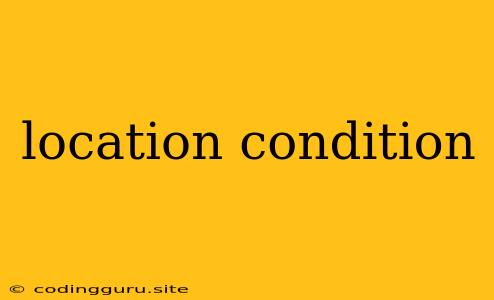Understanding "Location Condition" in the World of Web Development
In the realm of web development, "location condition" is a term you'll encounter frequently when working with various technologies like JavaScript, Node.js, React.js, and Next.js. It fundamentally relates to the concept of dynamically adjusting the behavior or content of your web application based on the user's geographical location. This powerful technique allows developers to create a more personalized and relevant experience for users across the globe.
Why is Location Condition Important?
Imagine a scenario where you're building an e-commerce website selling products. You might want to display different promotions or pricing depending on where a user is located. For instance, a "Buy One Get One Free" offer could be applicable to users in the United States, while a discount on specific items might be offered to users in Europe. This is where "location condition" comes into play.
Beyond e-commerce, location-based logic has numerous applications:
- Content Localization: Displaying content in different languages based on the user's region.
- Geo-targeting: Targeting ads or promotions specifically to users in a particular geographical area.
- Personalizing Features: Enabling features or functionalities unique to users in a certain location.
How Does Location Condition Work?
The foundation of implementing location condition is obtaining the user's geographical information. This is typically achieved through the user's IP address. There are several libraries and APIs readily available that can help you determine a user's location based on their IP:
- Geolocation API (JavaScript): This built-in browser API provides access to the user's location if they have granted permission.
- IP-based Location Services: Several third-party services offer APIs that allow you to retrieve location data based on an IP address. Examples include:
- IP-API:
- FreeGeoIP:
Implementing Location Condition
Let's dive into a practical example using JavaScript to display a different welcome message based on the user's location.
Code Example (JavaScript):
function getLocation() {
if (navigator.geolocation) {
navigator.geolocation.getCurrentPosition(showPosition, showError);
} else {
alert("Geolocation is not supported by this browser.");
}
}
function showPosition(position) {
let latitude = position.coords.latitude;
let longitude = position.coords.longitude;
// Use an API or service to determine location based on coordinates
// Example using IP-API:
fetch(`https://ip-api.com/json/?lat=${latitude}&lon=${longitude}`)
.then(response => response.json())
.then(data => {
let country = data.country;
let welcomeMessage = "Welcome to our website!";
if (country === "United States") {
welcomeMessage = "Welcome to our website from the US!";
} else if (country === "United Kingdom") {
welcomeMessage = "Welcome to our website from the UK!";
}
document.getElementById("welcome").innerHTML = welcomeMessage;
});
}
function showError(error) {
switch (error.code) {
case error.PERMISSION_DENIED:
alert("User denied the request for Geolocation.");
break;
case error.POSITION_UNAVAILABLE:
alert("Location information is unavailable.");
break;
case error.TIMEOUT:
alert("The request to get user location timed out.");
break;
case error.UNKNOWN_ERROR:
alert("An unknown error occurred.");
break;
}
}
getLocation();
Explanation:
getLocation(): This function uses the browser's Geolocation API to obtain the user's coordinates.showPosition(position): This function receives the coordinates from the Geolocation API. It then uses an IP-based location service to determine the user's country. Based on the country, a specific welcome message is displayed.showError(error): This function handles errors that might occur during the Geolocation request, such as permission denial or a timeout.
Best Practices for Location Condition
- Respect User Privacy: Always obtain explicit user consent before using their location data. Make sure to explain why you need it and how it will be used.
- Consider User Experience: Ensure your "location condition" logic doesn't disrupt or negatively impact the user's experience.
- Accuracy and Reliability: Choose a reliable IP-based location service that provides accurate data. Keep in mind that IP-based location is not always perfect and may have some inaccuracies.
- Fallback Mechanisms: Provide a fallback mechanism for situations where location data is unavailable or unreliable. This could involve displaying a general message or allowing the user to manually select their location.
Conclusion
"Location condition" is a powerful technique for enhancing the user experience of web applications. By dynamically adjusting content and behavior based on location, developers can create a more engaging and relevant experience for users worldwide. Remember to implement these techniques with user privacy, accuracy, and a user-centric approach in mind.
